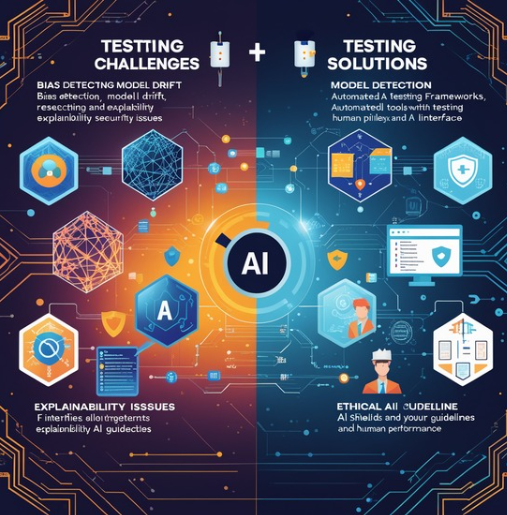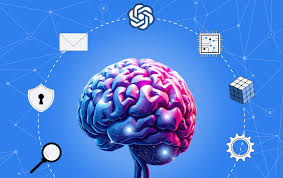Challenges and Solutions in Testing AI Applications
Artificial intelligence changes the way businesses operate. Many industries rely on testing AI to improve system performance and ensure safe outcomes. Companies build solutions that learn and adapt. AI powers decision-making and drives innovation. It helps reduce errors and supports growth in multiple sectors. The future looks bright indeed.
AI has become a key tool in solving complex tasks. Researchers and developers test systems to ensure accuracy and fairness. Data issues and model complexity present challenges. Many companies focus on precise evaluation and constant updates. Industry experts share insights from real-world projects and trials to meet strict standards today.
This blog will explore the challenges and solutions in testing AI applications. We cover topics that include model complexity, data issues, and evaluation methods. Your journey into clear and straightforward AI testing methods begins here. Start your learning journey now.
Complexity of AI Models
AI models have many layers and work with massive data. They use algorithms that learn from examples. Testing AI is essential to check if models work as planned. Developers face challenges in understanding model decisions.
Complexity arises from many variables. Many models use deep networks and multiple layers. It is hard to trace how one input changes the output. Teams work hard to simplify the process.
- Model Structure: The design of AI models includes several layers and many parameters that interact in complex ways to produce outcomes.
- Algorithm Behavior: The actions of algorithms depend on learned patterns and careful adjustments made during training sessions.
- Interpretability Challenges: Many experts examine outputs to connect input features with final decisions and uncover hidden patterns within the system.
Developers face many issues with AI models. They work to tune models to get better results, often adjusting parameters based on trial and error. The math behind decisions stays hidden to many. Teams use simple checks to see if outcomes match goals.
Testing AI remains a key step to catching faults early. Models can be unpredictable if the data changes. Teams use standard tests to compare model behavior. They design experiments to check output under different conditions. Developers use regular testing AI practices to maintain model accuracy.
Data Issues in AI Testing
Data forms the basis of AI systems. Many errors result from data issues. Developers use precise methods when testing AI processes that need clean and clear data. Problems arise from missing entries and wrong labels. Teams work to ensure fairness in data collection. Many errors occur when data sources are misused.
- Data Quality: Ensuring the data is complete and accurate can reduce errors in model predictions and build trust in the outcomes.
- Data Volume: Large amounts of data can improve learning but may also introduce noise and make the system respond more slowly.
- Data Bias: Imbalanced data can lead to unfair results and must be identified before deployment to avoid negative impacts.
Developers must review data sets to remove mistakes. They check for consistency in labels and values. Testing AI methods checks whether the data represents real situations. Teams use statistical checks to see if the data distribution is fair. They run tests to spot outlier points. Many errors appear when data has gaps. Clear data sets improve results.
Some developers use a cloud mobile phone connection to gather remote data samples from various locations. Testing AI plays a key role in verifying the accuracy of data handling. Teams use regular testing AI to ensure data issues are caught before production.
Evaluation Metrics and Benchmarks
Evaluation metrics show how well a model works, and benchmarks compare performance across tests. Clear measures help teams make good decisions. Testing AI helps teams understand whether models meet goals. Many measures check speed, accuracy, and fairness. Developers set targets to see if outputs meet expectations.
- Accuracy Measures: Evaluating predictions against actual outcomes can show how well the model performs tasks.
- Speed Metrics: Timely test responses help confirm if the model can work under expected loads and data volume.
Benchmarks help teams compare different models. Developers use past data to set clear targets.
Testing AI improves decision-making on model adjustments. Teams study charts and reports to check improvements. Simple tests can show trends over time. Experts prefer clear numbers to subjective views. Developers adjust parameters based on these metrics. They update models after comparing test results.
Ethical and Bias Concerns
Ethical questions matter in AI work. Developers check if models harm any group. Testing AI is vital to find bias early. Experts study data to find patterns that cause unfair results. Teams use straightforward methods to measure fairness. They work to keep outcomes equal for all users. Developers run tests to check for bias in input and output.
Many teams set guidelines to maintain ethical practices. They share findings with peers to improve their methods. Clear rules help prevent bias. Teams correct bias when it appears. They also use simple tests to check fairness.
Developers update methods after careful review. Testing AI helps identify hidden issues. Teams commit to fairness and clear ethics throughout the process.
- Fairness Checks: Evaluating whether models treat all groups equally helps create just and reliable systems.
- Bias Mitigation: Teams study outcomes to spot unfair patterns and then work to correct them in system design.
Continuous Learning and Model Updates
AI systems change over time. Developers update models as new data comes in. Continuous learning helps keep systems current. Teams run regular checks to maintain performance. Testing AI helps catch errors in updates.
Model changes must follow clear plans. Developers add new data and adjust settings often. They also run tests to check if updates work well. Teams keep logs of changes. Clear updates improve model use, and regular changes help avoid mistakes.
Developers use simple tests to verify if modifications meet standards. They review updates and act on feedback. Consistent learning drives improvement and system stability.
Resource and Expertise Constraints
Many teams struggle with limited skills and funds in AI projects. Experts work hard to meet demands. Training new staff takes time. Small groups often face many challenges. Teams seek precise methods to train models with fewer resources. They rely on open data and simple tools. Testing AI remains a key step in checking system reliability. Funding and skilled staff are hard to find in many cases.
The cloud testing platform helps teams run tests from different locations. It enables fast checks on system behavior under various conditions and offers access to multiple test environments in a single place.
To make testing easier, you can use LambdaTest’s AI-powered Test Intelligence platform. It offers features like auto-healing, flaky test detection, and RCA. More AI-driven tools are also available. These help improve software reliability and speed up delivery.
KaneAI by LambdaTest is an AI-powered QA agent. It helps teams create, debug, and improve tests using simple language. It is designed for fast-moving QA teams. With KaneAI, you need less time and expertise to start test automation.
Resource limits make progress slow. Experts share tips in online forums. They work in small groups to solve problems. Training sessions improve skill levels. Teams find support from community events. Developers use clear plans to manage tasks.
Performance Optimization in AI Testing
Optimizing the performance of AI systems is key to efficient outcomes. Developers focus on improving speed and accuracy in their projects. They design tests to check if each component works well.
Testing AI plays a significant role in ensuring systems perform as expected. Teams work on reducing delays and checking output precision. Continuous checks help maintain system quality and user outcomes.
- Speed Checks: Teams run tests that measure how quickly models return accurate answers under different data loads and conditions.
- Accuracy Measures: Experts measure the closeness of predictions to absolute values using detailed tests that compare expected and actual outcomes.
- Resource Management: Developers review system usage and memory consumption to maintain high performance and ensure smooth operation during intensive tasks.
Engineers analyze performance data and adjust settings for optimal results. They study logs and charts to identify areas for improvement. Teams share findings in meetings and update strategies based on feedback.
Regular updates and tests help catch slowdowns before they affect users. The focus remains on clear improvements and timely adjustments. This approach ensures systems run efficiently. This ensures optimal performance.
User Experience and Interface in AI Applications
User experience remains key to the success of AI applications. Clear interfaces help users get the correct results. Developers design systems that are easy to use and understand and run tests to check for smooth interactions.
AI applications must respond quickly and provide clear instructions. Designers seek user feedback and update systems to meet user needs.
- Interface Clarity: Teams design simple screens and clear labels to ensure users find answers without extra steps or confusion in interactions.
- Interaction Testing: Developers check if each user action triggers expected responses promptly and if systems handle errors gracefully.
- Feedback Integration: Engineers gather user comments and conduct direct tests to determine whether interface changes meet user expectations and improve overall ease of use.
Developers monitor user sessions and study logs to identify areas for improvement. They also run surveys to gauge satisfaction. Tests help determine whether instructions are clear and whether the navigation works well. Based on feedback, teams update the design.
The goal remains to create AI applications that work simply and give users clear paths to solutions. This process keeps systems easy and practical for everyone, keeping the experience straightforward and engaging.
Conclusion
The blog has discussed key issues in AI application testing. Challenges include model complexity, data problems, and ethical concerns. Clear checks and regular updates help fix issues. The blog also gave practical tips for improving system outcomes. Teams must work together to solve these problems.
Regular reviews and clear guidelines keep models safe. Experts work hard to correct issues. Small steps lead to better results. Ongoing improvements help meet new challenges. Collaboration among professionals is vital for secure systems.
Recommended posts
Comprehensive Guide to firstkey dumping 48000 homes






